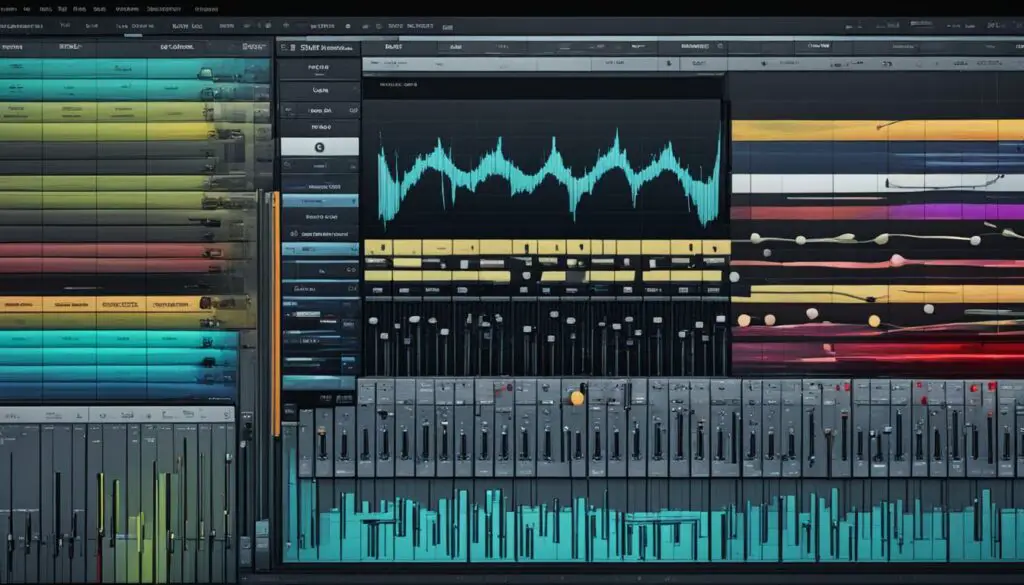Can you use live vocals for mashups?
Exploring the art of vocals-over-beat mashups is thrilling for DJs and music producers. This article will cover techniques, tools, and legal aspects for making unique musical mixes. You’ll learn how to blend live vocals with beat instrumentals to improve your DJ skills and make memorable mashups.
Mashups let DJs add their unique touch to their sets by mixing different songs. Using live vocals and beat instrumentals can take your mashups to new heights. This article will show you how to prepare vocals and instrumentals, process audio, and mix and master your mashup.
Get ready to dive into acapella remixes, vocal isolation, and remix contests. These techniques can help you improve your DJ skills and make a mark on the dance floor with your innovative mashups.
What is a Vocals-Over-Beat Mashup?
A vocals-over-beat mashup mixes live or isolated vocals with a beat or instrumental. This method, known as an acapella remix, merges the main vocals from one song with another’s backing track. To make these mashups, producers use acapella versions or isolate the vocals from the original song. They also need remix stems or beat instrumentals to mix with the vocals.
Defining Acapella Remixes and Vocal Isolation
An acapella remix takes the lead vocals from a song and removes the original backing track. Producers can find acapella versions or isolate the vocals using special techniques. This lets them pair the vocals with a new instrumental or beat.
Beat Instrumentals and Remix Stems
For a vocals-over-beat mashup, producers also need beat instrumentals or remix stems. Beat instrumentals have only the rhythm, like drums and bass, without vocals. Remix stems are files for each song part, including vocals, instruments, and effects.
| Key Elements for Vocals-Over-Beat Mashups | Description |
|---|---|
| Acapella Remixes | Versions of a song with the lead vocals isolated from the original backing track |
| Vocal Isolation | The process of extracting the lead vocals from a full song mix |
| Beat Instrumentals | Individual tracks containing only the rhythmic elements, such as drums, percussion, and bass lines |
| Remix Stems | Separate audio files for each individual element of a song, including vocals, instruments, and effects |

By using these elements, producers can make unique vocals-over-beat mashups. These blend the emotional power of live vocals with the rhythm of a beat or instrumental.
Preparing Vocals and Instrumentals
Before making a mashup with vocals over a beat, producers need to get the vocals and instrument ready. This important step makes sure everything works well together. It leads to a polished and professional sound in the end.
Key Matching and Time Stretching
The first step is to key match the acapella vocals with the beat instrumental. This means changing the vocals to the same key as the track. Also, time stretching the vocals is needed to match the beat. This makes sure the vocals and the music go together smoothly.
Arranging and Aligning Vocal Phrases
After fixing the key and timing, it’s time to arrange the vocal phrases. The producer must place the vocals carefully. This makes sure they work well with the beat and sound good together. Vocal alignment is key to make sure the vocals and music are in sync.
By carefully preparing the vocals and instrumentals, producers set a strong base for their mashup. These steps are essential for a great final mix.

EQing and Processing Vocals
When mixing live vocals with beat instrumentals, it’s key to blend them well. Producers use vocal EQ and effects to make the vocals sound great. They remove low-end frequencies to avoid a muddy sound. Then, they add reverb or vocal effects for a natural feel.
Removing Low-End Frequencies
Starting with low-end removal is crucial for vocal processing. Vocals often have too much low-frequency content. This can clash with the beat. By cutting the 250Hz band, producers can clear up the sound and let the beat stand out.
Using resonance reduction at 250Hz and 3kHz also helps. This reduces frequency overlap between the beat and vocals. For a precise touch, frequency-specific ducking can lower the beat’s high frequencies when the vocal is loud. This makes the vocal sound better with the music.
Adding Reverb and Effects
Adding reverb and vocal effects can greatly improve the vocal. Techniques like tube distortion, mild ramping, and signal degradation make the vocal stronger and more centered.
Compression with lookahead and makeup gain brings out vocal details and keeps the volume steady. M/S EQ helps place the vocal better by boosting certain frequencies. This makes the vocal blend well with the music.
Using tape saturation on mid frequencies and clean tube saturation on highs adds depth to the sound. Time-based effects like reverb and 1/8th note delay with ducking also enhance the vocal. These effects make the vocal fit perfectly with the music.
Vocals-Over-Beat Mashup Production Techniques
There are many ways to make a vocals-over-beat mashup stand out. Producers can use vocal sampling and creative edits to add special touches. This part will look into these advanced ways to improve mashups.
Using Plugins like Endless Smile
Plugins like Endless Smile are key for producers. They can make the mashup more exciting and full of energy. By using Endless Smile and similar tools, producers can make the vocals fit perfectly with the beat. This makes the music more enjoyable to listen to.
- Plugins like Endless Smile can create exciting effects and buildups, making the mashup more energetic.
- Using these plugins wisely helps the vocals blend well with the beat, making the music engaging.
- Trying out vocal sampling and creative edits can give the mashup a unique touch.
Advanced production techniques can take mashups to a new level. They make the music more captivating with creative vocal sampling and vocal edits. Using plugins like Endless Smile can greatly improve the mashup.
Mixing and Mastering Mashups
The final step in making a great mashup is mixing and mastering. Producers need to balance the vocals and beat well. They should make sure neither one takes over. It’s also key to avoid distortion by managing the gain right. This guide will help you master the art of mixing and mastering for a professional mashup.
Volume Balancing and Gain Staging
Getting the right balance between vocals and instruments is key. Here are some tips for mixing and gain staging:
- Begin by setting the vocals and beat to roughly the same volume. This sets a good base for mixing.
- Use a soft limiter or compressor to blend the vocals with the beat. This makes them fit together well.
- Adjust each channel’s level and EQ the vocals and beat to get the sound you want.
- Make sure the loudest parts don’t go over 0 dB to avoid distortion.
- Think about using Ableton Live’s Vintage 1 mastering suite or similar tools for a final polish.
Don’t overdo compression or limiting, as it can make the mashup sound dull. The aim is for a mix that’s dynamic and balanced. This lets both the vocals and beat stand out.
Good gain staging in mixing and mastering is crucial for quality sound. By managing levels and avoiding clipping, producers can make a mashup sound professional and ready for release.
Beatmatching Acapellas
Beatmatching acapellas is key to making them fit well with the music. This can be hard because acapellas don’t have a clear beat. But, learning to do this is vital for making great mashups. This part will share tips and tricks for matching acapella vocals with the beat perfectly.
DJs love using acapellas for their creativity. They can mix vocals from one song with another’s music. But, since acapellas don’t have a beat, it takes skill to line them up right. DJs who started with vinyl find this easier, showing an edge for those with traditional training.
Using beatgridding on acapellas can make DJing better, allowing for smooth effects like echoes. But, acapellas can be tricky because the vocals don’t always follow the beat. DJ software can help by figuring out the BPM and phrasing, making it easier to match with the music.
- Adjusting the BPM of acapellas and the beatgrid can help DJs match vocals with music better.
- For vocals that start early, DJs can sync them at the vocal section’s start or a bar early to keep the track’s flow.
- Experienced DJs might not use beatgridding as much, preferring to mix by feel, tapping their foot to align the vocals.
The author talks about using acapellas to link tracks and add energy on the dance floor. They share examples of acoustic bridges in a video. The author also offers a course on finding and using acapellas in DJ sets. A bundle of DJ courses is available at a discount.
| Acapella BPM Reading | Actual Song BPM |
|---|---|
| 86 – 107 | 85 |
Programs show the vocals’ BPM as between 86 and 107, but the song’s BPM is 85. Fruity Loops can find a vocal track’s BPM, and the “Fit to Tempo” feature can sync vocals with the music. DIY acapellas can be tricky to get the BPM right.
To match vocals with the beat, line up phrases with the original track, start with the first kick, and get the rhythm of the vocals. Tracks without BPM info can be hard to sync. It’s key to fill in the BPM accurately for easy tempo adjustment.
Some music platforms let users add a BPM field. Cutting and re-timing vocal phrases can help them fit the beat. For rap vocals, you might need to chop and re-time them too.
Legal Considerations and Remix Contests
Making mashups and remixes can be fun and rewarding. But, producers must deal with complex legal issues. Using live vocals, acapella remixes, and beat instrumentals in mashups brings up questions about copyright and licensing.
Producers need to make sure they have the right permissions to use the original songs in their mashups. This often means getting licenses or entering official remix contests. If they don’t get the right permissions, they could face legal trouble, like copyright infringement claims, and their content might get taken down from places like YouTube and SoundCloud.
Navigating Remix Contests
Official remix contests are a legal way to make and share mashups. These contests, run by the song’s artists or labels, give out stems of the song and let participants post their remixes online. They’re a great chance for producers to show off their skills, connect with fans, and maybe get noticed by the original artists or labels.
- Winning remixes might get played at festivals or live shows, giving producers great exposure and career boosts.
- Stems are the separate parts of a song like drums, bass, vocals, and effects. These are usually given out through contests or on websites like Splice and Loopmasters.
- Getting permission through contests lets producers share their work online without worrying about copyright issues.
Clearing Samples and Securing Licenses
For producers making mashups outside contests, getting the right licenses and clearances is hard. Even a small part of a song might need permission from the copyright owner. Not getting this permission can lead to legal trouble and getting your content taken down.
Groups like the MCPS (Mechanical-Copyright Protection Society) and PRS (Performing Right Society) can help with the licensing process. They guide producers on how to use samples and pre-existing recordings in their acapella remixes and vocals-over-beat mashups.
| Consideration | Explanation |
|---|---|
| Legal Clearance | Getting the rights and permissions needed to use original recordings in a mashup or remix. |
| Remix Contests | Official challenges for producers that give out stems and let you legally share remixed songs. |
| Sample Clearance | The process of getting approval to use parts of a song in a new work. |
Understanding legal issues and using remix contests can help producers make acapella remixes and vocals-over-beat mashups that respect the original artists’ rights. This way, they can avoid legal problems.
Conclusion
The art of making vocals-over-beat mashups is full of possibilities for DJs, producers, and music fans. By learning how to prepare vocals and instrumentals, and using advanced mashup production techniques, you can create unique sounds. Always think about the legal side and get the right permissions when working with acapella remixes and entering remix contests. With hard work and creativity, you can improve your skills and make your mark in mashup culture.
This article talked about the key of aligning vocal layers and the important frequencies for processing rap vocals. It gave tips on compressors, delays, and reverb to make vocals clear and distinct. It also stressed the need for a good recording and editing of vocals, and how automation and EQ help keep vocals consistent across different music styles.
Using what you’ve learned from this article, you can make your vocals-over-beat mashups stand out. Keep exploring the creative side of this genre and see how far you can go with acapella remixes and mashup production.







